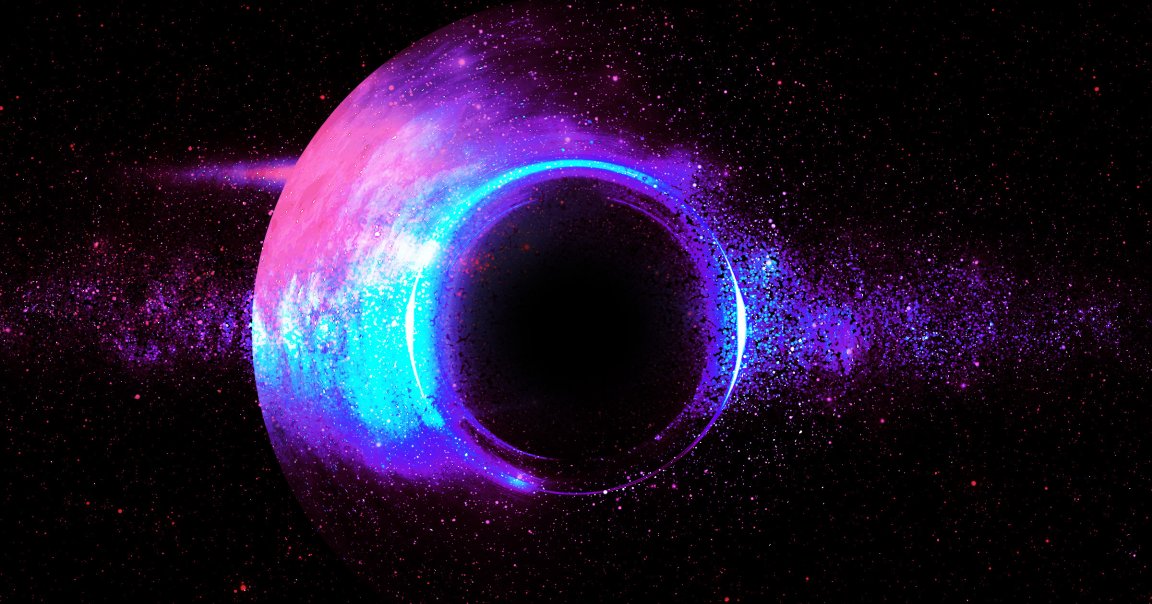
New fear unlocked: spontaneous black hole implosion.
Fresh research predicts that planets may be able to accumulate enough dark matter to suddenly form a black hole at their core. As the intruder grows, catastrophe unfolds: it would then devour the world from the inside out, becoming a black hole with the same mass as its unfortunate meal.
The findings, published as a study in the journal Physical Review D, are terrifying to contemplate. The intent, however, wasn’t to haunt our dreams but to demonstrate a potential new avenue for studying dark matter, the invisible substance that accounts for 85 percent of all mass in the universe. Oh, and this would only affect gas planets, so the Earth is safe for now.
“In gaseous exoplanets of various sizes, temperatures, and densities, black holes could form on observable timescales, potentially even generating multiple black holes in a single exoplanet’s lifetime,” co-lead author Mehrdad Phoroutan-Mehr, an astronomer at the University of California, Riverside, said in a statement about the work.
“These results show how exoplanet surveys could be used to hunt for superheavy dark matter particles, especially in regions hypothesized to be rich in dark matter like our Milky Way’s galactic center.”
Astronomers still don’t know what dark matter actually is. We know it exists because of its gravity, which governs the formation of the largest structures in the cosmos. Beyond that, it’s a veritable apparition.
The prevailing model suggests that dark matter is made up of weakly interacting massive particles, or WIMPs, which are heavy and slow enough that they clump together and form enormous dark matter “halos” that give birth to entire galaxies. WIMPs also don’t interact with ordinary matter and even light, rendering them effectively invisible. It’s hypothesized that these particles can annihilate each other upon colliding, releasing gamma rays that should be detectable, but so far, efforts to detect signs of these collisions have come up short.
In the study, the researchers go down a different route and propose that dark matter particles are heavy but don’t annihilate. Near the center of the galaxy, where dark matter concentrations are the highest, that means that a massive gas giant like Jupiter could capture some of these dark matter particles in its core. There, rare interactions between the dark matter and ordinary matter could result in the dark matter particles losing their speed, clumping together, and becoming dense enough to spawn a black hole. This could happen in as little as ten months, they found.
Surprisingly, this may not necessarily spell doom for whatever world is unlucky enough to find itself incubating a cosmic monster.
“Whether a black hole inside a planet survives or not depends on how massive it is when it first forms,” Phoroutan-Mehr told Physics World. If it starts off small enough, it may wink out before it has a chance to feed and grow.
“Interestingly there is also a special in-between mass where these two effects balance each other out,” Phoroutan-Mehr added. “In that case, the black hole neither grows nor evaporates — it could remain stable inside the planet for a long time.”
If these black hole planets exist, we should be able to detect them somewhere near the center of the galaxy. Exoplanets, then, could be a valuable way for exploring and testing our understanding of dark matter. But finding these planets would be easier said than done. For one, they’d be gravitationally indistinguishable from ordinary planets. And while they would be unusually hot, this can be explained by a myriad of less extraordinary phenomena.
“Rather, our point is that if detailed studies reveal temperatures that cannot be explained by ordinary processes,” Phoroutan-Mehr told Physics World, “then dark matter could be considered as one possible — though still controversial — explanation.”
In lieu of that, other findings could be extremely encouraging — like a tiny black hole, for instance.
“Discovering a black hole with the mass of a planet would be a major breakthrough,” Phoroutan-Mehr said in the statement. “It would support the thesis of our paper and offer an alternative to the commonly accepted theory that planet-sized black holes could only form in the early universe,” he explained, referring to what’s known as primordial black holes.
Ideally, we’d document a large population of these diminutive singularities. That “could offer strong evidence in favor of the superheavy non-annihilating dark matter model,” Phoroutan-Mehr said in the statement.
As to whether our solar system’s planets could meet their end by spawning a black hole, it’s unlikely. We’re about 26,000 light years from the center of the Milky Way — not that there aren’t other cosmic horrors we should be concerned about, of course.
More on space: The Object at the Center of Jupiter Is So Strange That It Defies Comprehension